Nepal is home to some of the remarkable UNESCO World Heritage Sites. Heritage sites in Nepal vary from natural wonders to magnificent cultural landmarks. While some are keepers of history's splendor, some are sheltered and lavish havens for thriving biodiversity. These landmarks are bold and beautiful and showcase Nepal's rich cultural and natural dimension that is truly awe-inspiring. The World Heritage Sites of Nepal have numerous structurally rich tourist spots that showcase the creative magnificence of Nepal and lavish national parks that allow biodiversity to prosper.
UNESCO has identified ten historical sites of Nepal as World Heritage Sites. Among them, 8 are cultural heritage sites with centuries-long historical backgrounds, while 2 are natural heritage sites. Travelers are welcome to discover these brilliant landmarks and appreciate Nepal's grand and astonishing legacies. Whether you are a nature lover or a history and culture buff, the World Heritage Sites of Nepal have something to offer you.
In this guide, you’ll find the names, locations, and key details with facts, fees to enter, and highlights of all 10 heritage sites of Nepal—plus insights on why they matter and how to experience them.
World Heritage Sites In Nepal
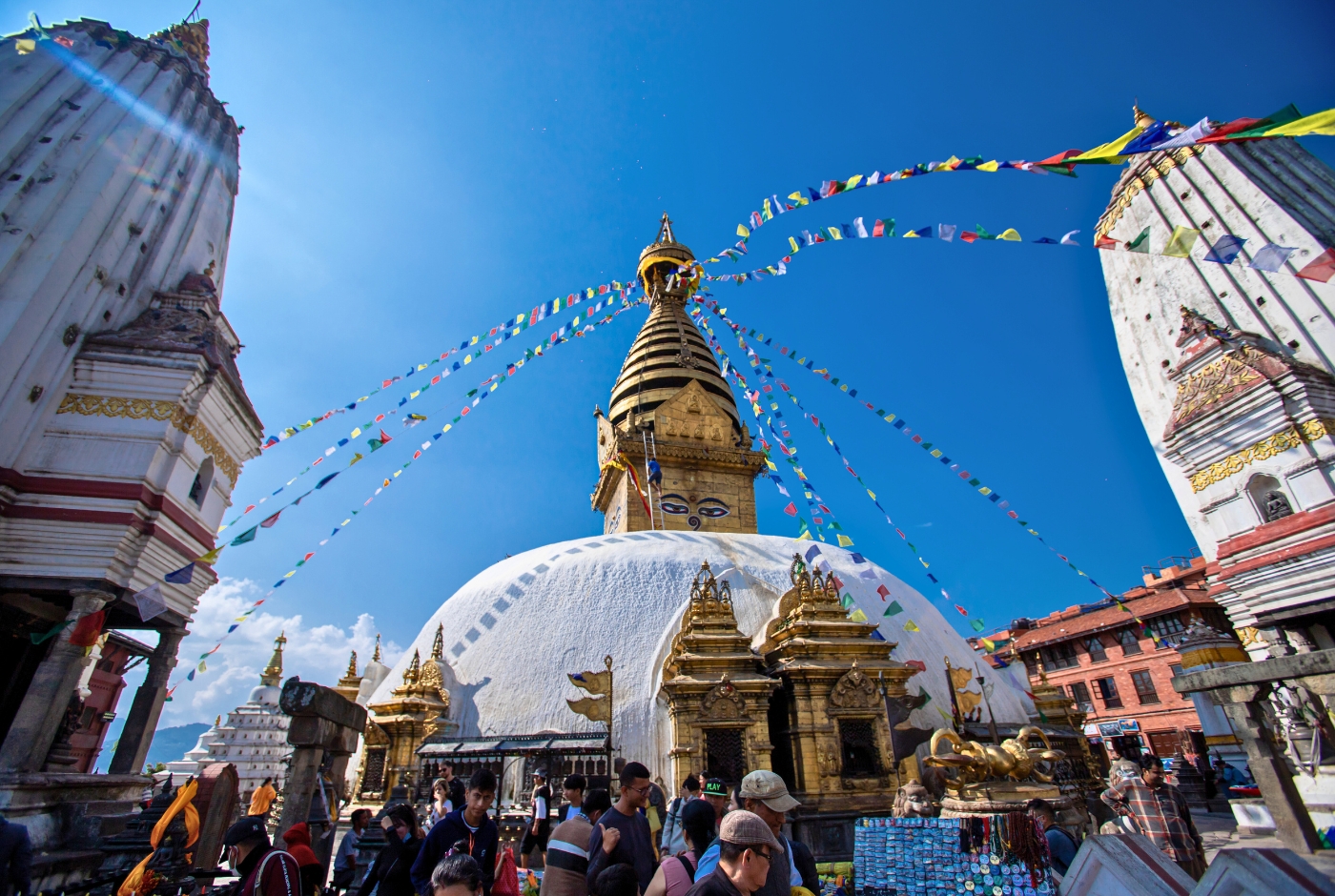
How many World Heritage Sites are in Nepal?
Nepal has four UNESCO World Heritage Sites—two natural and two cultural. The natural sites are Sagarmatha National Park and Chitwan National Park, while the cultural sites are Kathmandu Valley and Lumbini. The Kathmandu Valley listing covers seven individual monuments and landmarks, including the Durbar Squares of Kathmandu, Patan, and Bhaktapur; the Buddhist stupas of Swayambhunath and Boudhanath; and the Hindu temples of Pashupatinath and Changu Narayan.
The 10 UNESCO World Heritage Sites of Nepal are outlined below.
| List of Heritage Sites | Established Date | Listed in UNESCO | Interesting Facts and Shorter Details | Location |
| Kathmandu Durbar Square | Ancient period | 1979 |
|
Kathmandu Valley |
| Bhaktapur Durbar Square | 12th century | 1979 |
|
Bhaktapur, Kathmandu Valley |
| Patan Durbar Square | 3rd century BC | 1979 |
|
Lalitpur, Kathmandu Valley |
| Changu Narayan Temple | 4th century AD |
1979 |
|
Bhaktapur, Kathmandu Valley |
| Swoyambhunath Stupa | 5th century AD | 1979 |
|
Kathmandu Valley |
| Boudhanath Stupa | 14th century | 1979 |
|
Kathmandu Valley |
| Pashupatinath Temple | 5th century AD | 1979 |
|
Kathmandu Valley |
| Lumbini | 3rd century BC | 1997 |
|
Rupandehi District |
| Chitwan National Park | 1973 | 1984 |
|
Chitwan, Southern Nepal |
| Sagarmatha National Park | 1976 | 1979 |
|
Solukhumbu District |
Kathmandu Durbar Square
Location: Kathmandu Durbar Square, Kathmandu, Bagmati Province; Established date: Licchavi period (4th–8th century AD); Listed: World Heritage Site in 1979; Highlight: Historic palace, Newar architecture, and living goddess tradition.
Kathmandu Durbar Square: Heritage Sites of Nepal
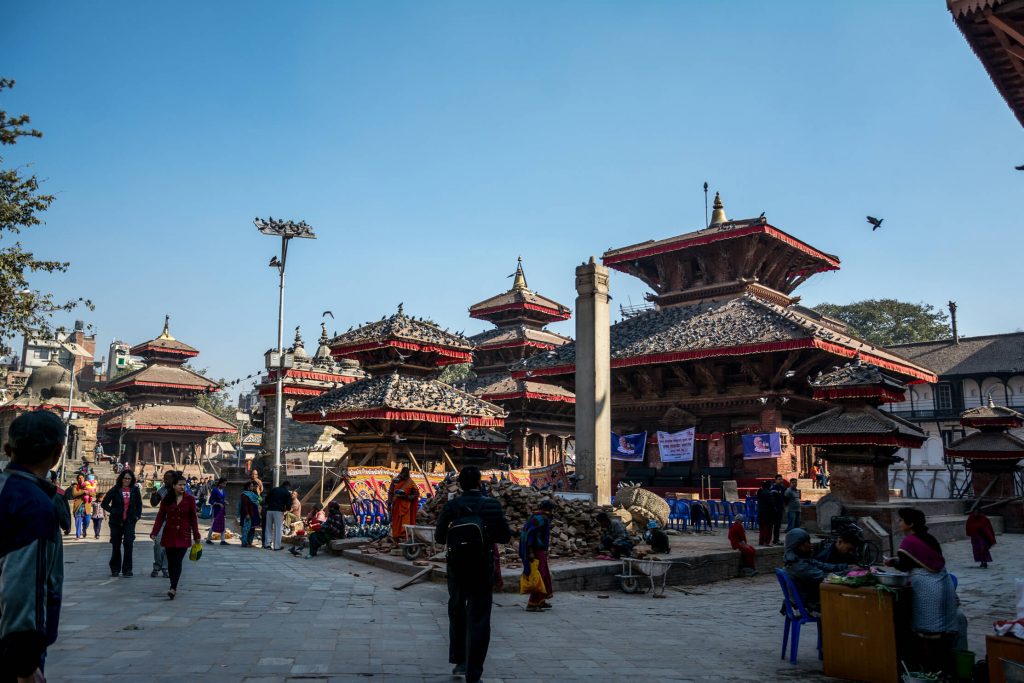
Otherwise called Hanuman Dhoka or Basantapur Durbar Square, Kathmandu Durbar Square lies in the core of Kathmandu Valley. In English, ‘durbar’ translates as a palace. The Durbar Square is located in the notable focal point of old Kathmandu. The square is an outdoor gallery of grand ancient temples, pagodas, structures, and holy places. The castle once used to be involved by Nepal's sheltered imperial family and is still home to the Kumari, Kathmandu's one-of-a-kind living goddess. So, while in Kathmandu Durbar Square, remember to look at Maru Tole, Kumari Ghar, Taleju Temple, Seto Bhairab, and Hanuman Dhoka Palace Museum.
Highlights of the Kathmandu Durbar Square
- Unique pagoda-roofed temples and royal residences
- Fine metal, stone, and woodwork created by Newari artisans
- Old alleys leading to ancient localities dating back to medieval times
Kathmandu Private/Group Tour - 2025
The main attractions you can see in Kathmandu Durbar Square
- Hanuman Dhoka Durbar, a complex of royal palaces and courtyard
- The historic Kasthamandap,
- The magnificent Taleju Temple,
- The Kumari Ghar (home of the living goddess)
- The Trailokya Mohan Temple and the Basantapur Tower
Additionally, the square features several notable courtyards and quadrangles showcasing medieval art.
Entry Fee
For SAARC nationals: NPR 150
For other tourists: NPR 1000
How to get to Kathmandu Durbar Square?
There are different ways to reach Kathmandu Durbar Square. The easiest way is to begin your excursion from Thamel. From here, take a road that leads to Chetrapati and head to Ason. The streets of Ason are primarily crowded and busy. You take the path to Indra Chowk and head towards Bishal Bazaar or take the narrow road known as Makhan. After walking for about a minute, you reach the Kathmandu Durbar square.; You can ask the locals for directions if you are all by yourself. If you don’t want to walk, taking a taxi from your hotel will be easier.
Bhaktapur Durbar Square
Location: Bhaktapur Durbar Square, Bhaktapur, Bagmati Province; Established date: 14th century; Listed: World Heritage Site in 1979; Highlight: Renowned for its 55-Window Palace and exquisite Newar craftsmanship.
Bhaktapur Durbar Square -Nepal Heritage Site
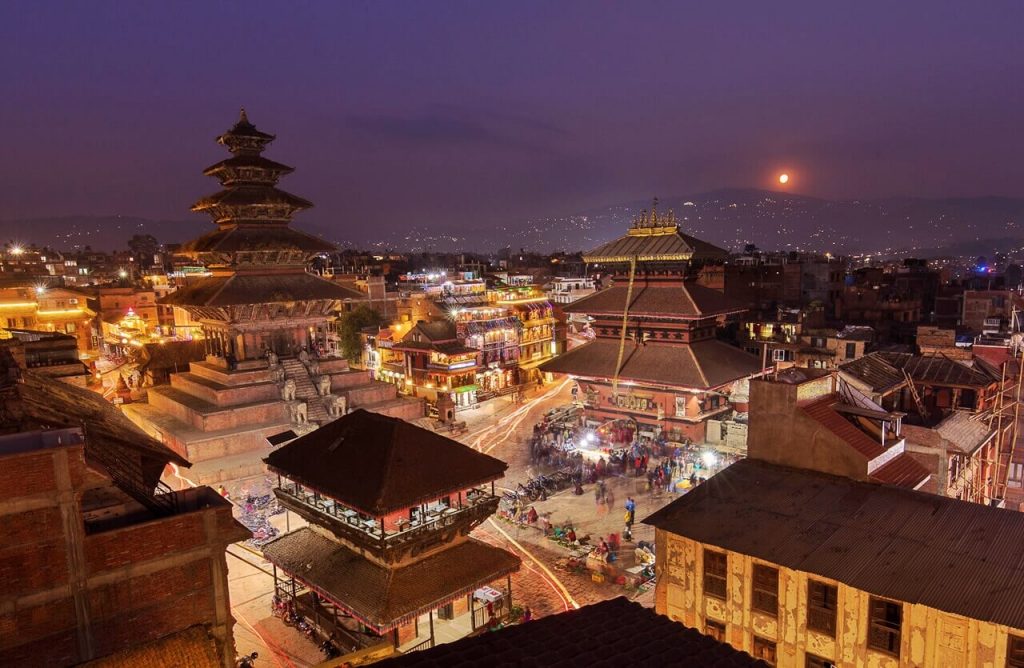
Bhaktapur Durbar Square, a famous UNESCO World Heritage Site since 1979, is another lovely milestone of Kathmandu Valley. Among the three urban communities of Kathmandu Valley, Bhaktapur is the smallest one. The city is famous for preserving and showcasing the traditional Newari life. The city has a mixed population of Hindu and Buddhist practitioners. Pottery Square, Dattatreya Square, Taumadhi Square, and Bhaktapur Durbar Square, which unfurls medieval Bhaktapur's rich culture and history, are must-visit sites.
Highlights of Bhaktapur Durbar Square
- Temples and palaces built in the pagoda and shikhara styles of architecture
- Opportunity to participate in traditional pottery making at the Pottery Square
- Artistic wood carvings, stone sculptures, and metalwork
- Visit the Palace of 55 Windows, which used to be a royal residence
- Visit the Nyatapola Temple, once the tallest building in Kathmandu Valley
Entry Fee
For SAARC nationals and Chinese Citizens: NPR 500
For other tourists: NPR 1500
How to get to Bhaktapur Durbar Square?
You can take a taxi from Thamel to Bhaktapur. The duration of the drive is around 45 minutes in a taxi. Local bus services are also available. You need to be at Naya Bus Park or Ratna Park to take a local bus. Buses to Bhaktapur leave every ten or fifteen minutes from the bus stops. After reaching Bhaktapur, you may have to walk for about 10-15 minutes to reach the durbar square.
Patan Durbar Square
Location: Patan Durbar Square, Lalitpur, Bagmati Province; Established date: 3rd century BC (expanded in the 17th century); Listed: World Heritage Site in 1979; Highlight: Celebrated for its exquisite Newar architecture and the Krishna Mandir temple.
UNESCO World Heritage Site of Nepal - Patan Durbar Square
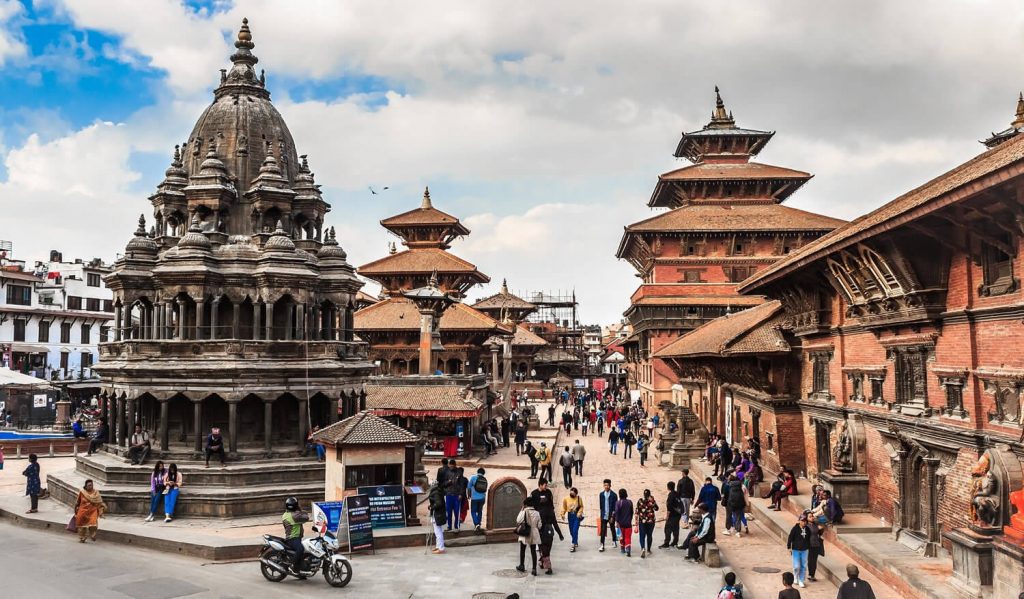
In 1979 AD, Patan Durbar Square has declared a World Heritage Site. Like Kathmandu, the old illustrious royal residence of Patan has a great Durbar square. This compact mass of temples is perhaps the most externally impressive showcase of Newari architecture in Nepal.; From the fourteenth to the eighteenth century, temple buildings in the square went into overdrive during the Malla period. Therefore, when visiting artificial works of art, do not miss to enjoy the temples of Lord Krishna and many other deities. Also, visit the museum and find out about the centuries-long history of the city.
Highlights of the Patan Durbar Square
- Ancient Hindu temples, Buddhist monasteries, and a palace dating back to the medieval period
- Krishna Temple, Golden Temple, Patan Palace Museum, Kumbeshwar Temple
- Ancient Newari settlements spread around the palace area
- Visit Patan Museum, which has some of the best collections of art and relics found in the Kathmandu Valley
Entry Fee
For SAARC nationals: NPR 250
For other tourists: NPR 1000
How to get to Patan Durbar Square?
You may take a taxi from Thamel to Patan Durbar Square. The taxi will drop you at the entrance of Durbar Square. It is around 20-minute drive from Thamel if the traffic isn't heavy.
Similarly, public transport services are also available. You can take a tuk-tuk or a public bus from Ratna Park or Sundhara Junction.
Changu Narayan Temple
Location: Changu Narayan Temple, Changunarayan, Bhaktapur, Bagmati Province; Established date: 4th century AD; Listed: World Heritage Site in 1979; Highlight: Nepal’s oldest Hindu temple with intricate Licchavi-era stone inscriptions and wood carvings.
Changu Naryan Temple - Cultural Heritage of Nepal
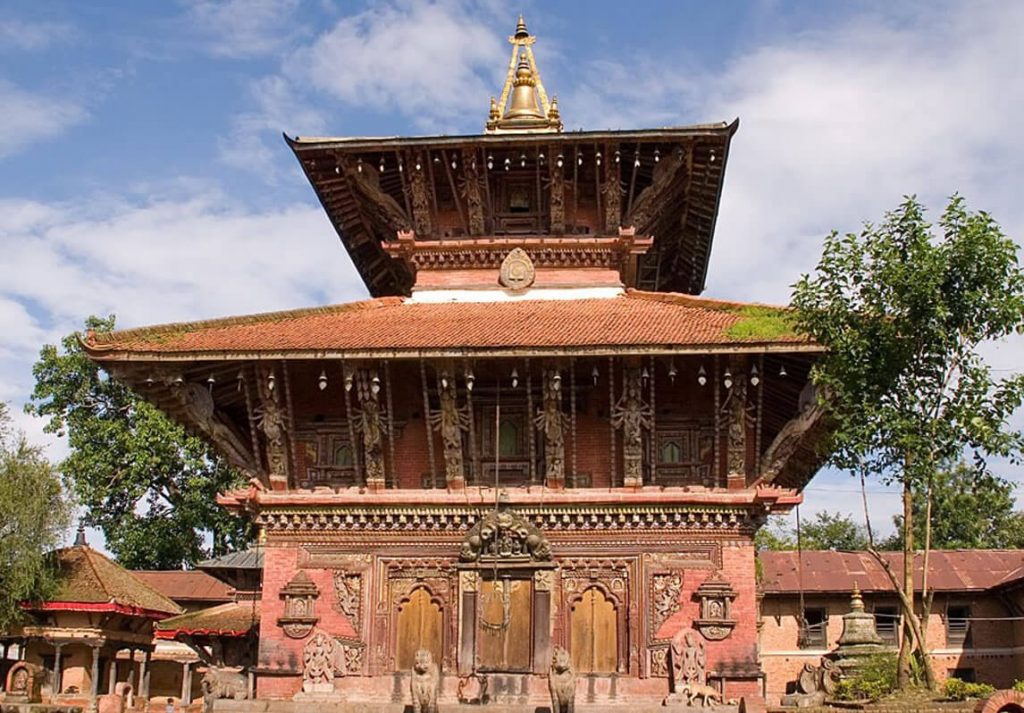
The origin of the Changu Narayan Temple can be traced back to the Lichchavi era, during the reign of Haridatta Burma in 323 BC. Changunarayan Temple is one of the oldest temples in Nepal and an old archeological site. Dedicated to Lord Vishnu, It was inscribed on the UNESCO World Heritage List in 1979.
Highlights of the Changu Narayan Temple
- Stone and wooden sculptures of all avatars of Lord Vishnu
- The oldest written inscription (Sanskrit) discovered in Nepal
- Peaceful and idyllic setting. The temple lies in a forest.
- Visit the Changu Museum. Observe the extraordinary carvings dating from the Lichchavi era dotted in the courtyard.
Entry Fee
- For SAARC nationals: NPR 100
- For other tourists: NPR 300
How to get to Changu Narayan?
Direct buses to Changu Narayan from Kathmandu are not available. However, you can take a public bus to Changu Narayan from Bhaktapur. You can reach Bhaktapur by taxi or via public bus. Public Buses to Bhaktapur are available from Old Bus Park or Ratna Park.
Changu Narayan is a popular spot for day hiking from Bhaktapur, and you can take a day hike to the temple. A less time-consuming and comfortable option would be to take a taxi from your location.
Swoyambhunath Stupa
Location: Swayambhunath Stupa, Kathmandu, Bagmati Province; Established date: 5th century CE (circa 460 AD); Listed: World Heritage Site in 1979; Highlight: Ancient hilltop stupa offering panoramic views and sacred monkey sanctuary.
Heritage of Nepal: Swoyambhunath Stupa
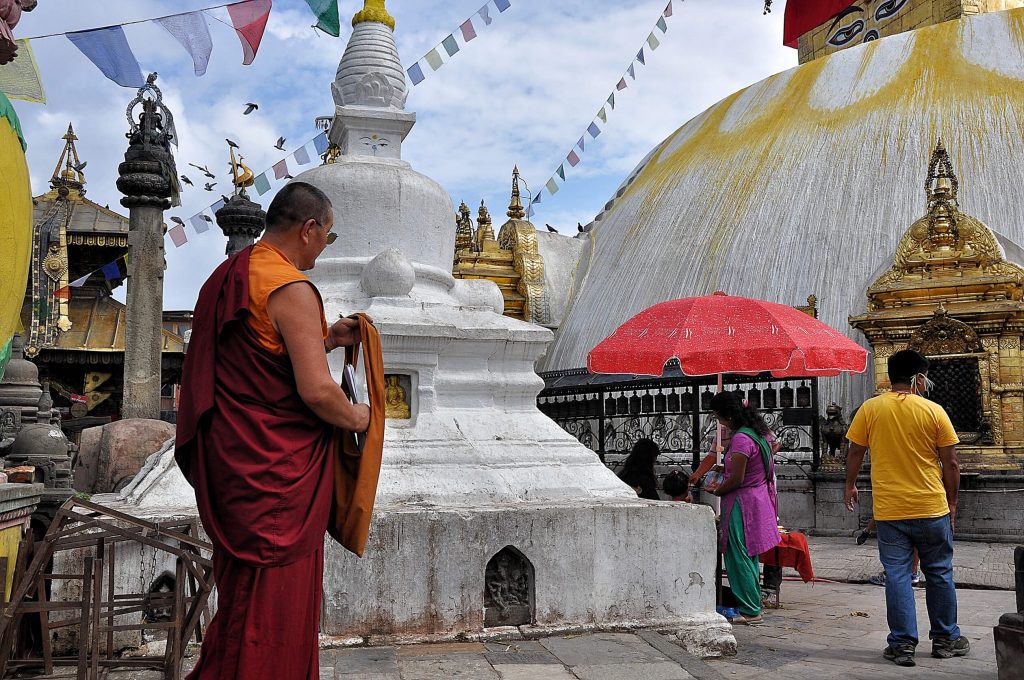
The famous whitewashed stupa of Swoyambhunath is one of the most consecrated Buddhist places of worship in Nepal. The stupa is otherwise called Monkey Temple because of the many monkeys residing on the temple grounds. The stupa is recognized for its iconic eyes in the electric mishmash of prayer flags. Travelers meander the sanctuaries, turning supplication haggles mantras. Coming to Swoyambhunath is a beautiful experience, with old carvings stuck into each square inch of the space and the smell of incense filling the atmosphere. According to local legend, the origin of Kathmandu is linked to the building of this stupa by Boddhisattva Manjushri.
Highlights of the Swoyambhunath Stupa
- Ancient Buddhist stupa with the four eyes of Buddha
- 360-degree view of Kathmandu Valley from the temple grounds
- An opportunity to observe locals worshipping at the shrines
- Witness a balanced harmony between two religions - Hindu and Buddhist
Entry Fee
For SAARC nationals: NPR 50
For other tourists: NPR 200
How to get to Swoyambhunath?
You can reach Swoyambhunath by taxi. The stupa lies close to Thamel, about a 35-minute walk. You can also take a public bus from Sorahkhutte. The bus stops at the bottom of the hill where the stupa is located. You will have to hike for 15-20 minutes to reach the stupa. The hike could be fun as you encounter many monkeys en route.
Boudhanath Stupa
Location: Boudhanath Stupa, Kathmandu, Bagmati Province; Established date: 5th–6th century AD; Listed: World Heritage Site in 1979; Highlight: One of the world's largest spherical stupas, central to Tibetan Buddhist culture.
Boudhanath Stupa: Nepal Heritage Sites
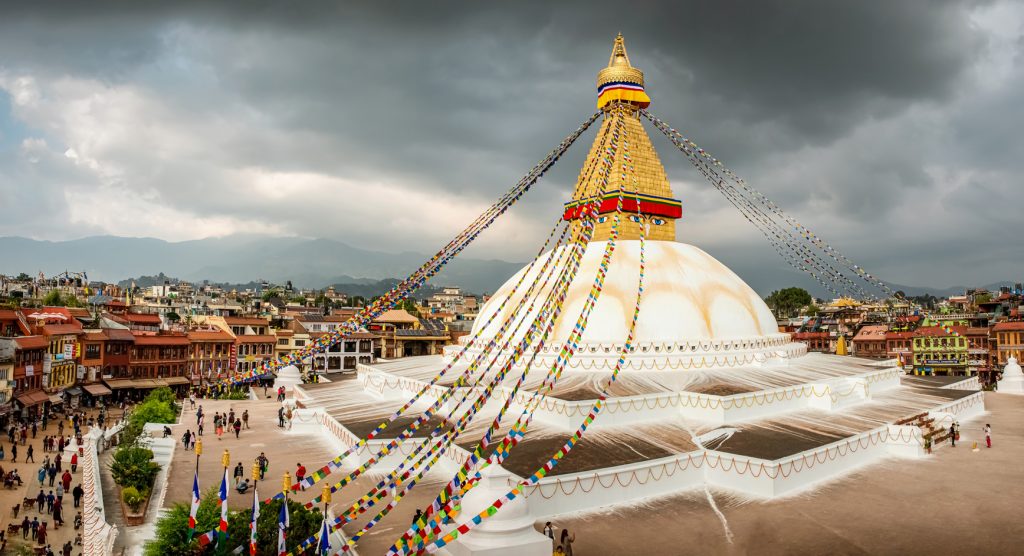
Boudhanath Stupa was founded in 600 AD by King Songtsen Gompa of Tibet. The stupa is one of the world's largest dome-shaped stupas. The dome is accurately proportioned and symbolic. The whitewashed dome and its gilded tower decorated with the all-seeing eyes of the Buddha act as a three-dimensional reminder of the journey of the Buddha to enlightenment.
Highlights of the Boudhanath Stupa
- At the base of the stupa, there are 108 small images of the Dhyani Budhha Amitabh and a ring of prayer wheels
- The ‘mandala’ at the base of the stupa is one of the largest in the world
- Opportunity to observe local pilgrims and interact with them
- Buddhist Monasteries, art galleries, souvenir shops, and cafes surrounding the stupa are worth visiting
Entry Fee
For SAARC nationals: NPR 100
For other tourists: NPR 400
How to get to Boudhanath Stupa?
You can take a taxi from your location. Public transportation is available from Ratna Park, Sundhara, and Gongabu. Every few minutes, buses leave for Boudhanath Stupa from all these stops. The buses will bring you to the entrance of the stupa.
Pashupatinath Temple
Location: Pashupatinath Temple, Kathmandu, Bagmati Province; Established date: 5th century CE; Listed: World Heritage Site in 1979; Highlight: Nepal’s holiest Shiva temple with sacred cremation ghats along the Bagmati River.
Heritage of Nepal: Pashupatinath Temple
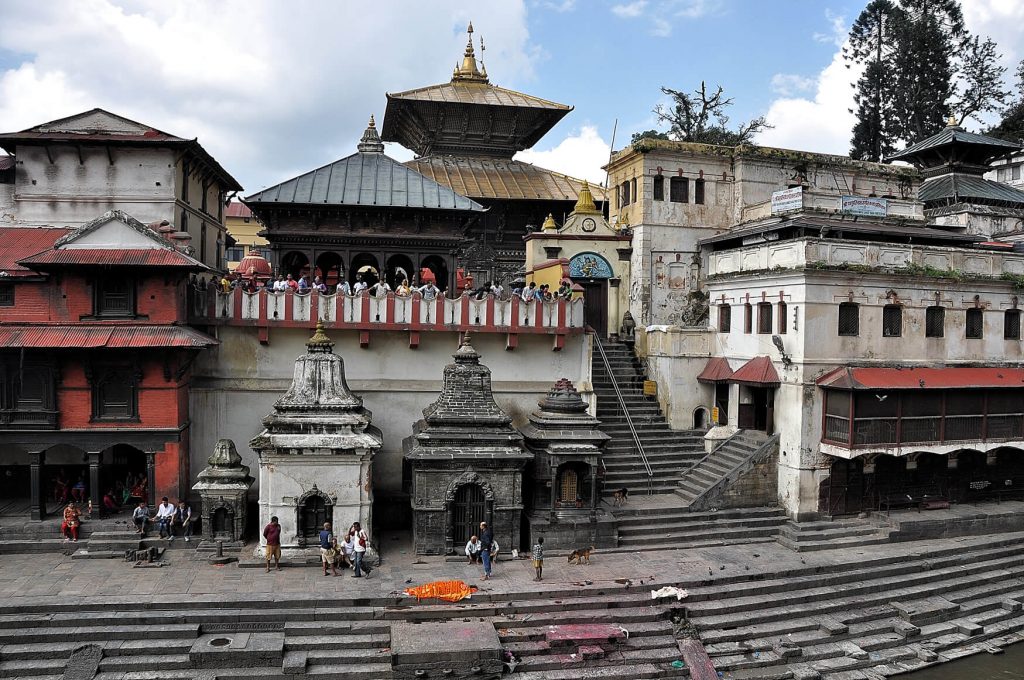
For Hindu devotees, Pashupatinath is a holy shrine. This magnificent temple lies beside the river Bagmati. Non-Hindus are not allowed inside the temple. They can view the temple from the eastern bank of the Bagmati River. A puja ceremony is held each night on the river banks below the temple, where hundreds of pilgrims participate. The temple also has one of the oldest Hindu cremation sites in Nepal.
Highlights of Pashupatinath Temple
- One of the oldest and holiest Hindu temples dedicated to Lord Shiva
- Sanctuary of Hindu ascetics known as ‘Sadhus.’
- Arya Ghat is a Hindu cremation site where dead bodies are burnt. One can observe Hindu cremation rites.
- Evening puja ceremony, which is a spiritually vibrant experience
Entry Fee
- Free for Indian citizens
- For other tourists: NPR 1000
How to get to Pashupatinath Temple?
It lies close to Tribhuvan International Airport. There are numerous local buses accessible from the central city to get to the Pashupatinath Temple. The easiest way to arrive at the temple is to take a taxi from your location.
Lumbini - The birthplace of Lord Buddha
Location: Lumbini, Rupandehi District, Lumbini Province; Established date: 6th century BCE; Listed: World Heritage Site in 1997; Highlight: Birthplace of Lord Buddha with sacred Maya Devi Temple and Ashoka Pillar.
Lumbini: UNESCO World Heritage sites of Nepal

Lumbini is the birthplace of Lord Buddha, the most excellent spiritual teacher. A UNESCO World Heritage Site, the town’s landmarks are the Maya Devi Temple, Sacrede Garden, Puskarini Pond, and the many monasteries built by different Buddhist countries. One can experience a feeling of tranquility and harmony here.
Highlights of Lumbini
- Maya Devi Temple, the spot where Buddha was born
- Ashoka Pillar, built by Emperor Ashoka, where it is inscribed that this s the spot of Lord Buddha’s birth
- Explore Puskarini Pond and Sacred Garden
- Visit the various monasteries, Lumbini Crane Sanctuary, and the Pagoda for World Peace.
Kathmandu and Lumbini Private Tour
Entry Fee
For SAARC nationals: NPR 100
For other tourists: NPR 200
How to get to Lumbini?
There are two different ways to arrive at Lumbini. You can drive overland or take a flight. It takes around 8-9 hours to drive from Kathmandu. Tourist buses and private vehicles on hire are available. It takes around 35 minutes;the flight lands at Bhairahawa Airport. You need to drive for around 30 minutes to arrive in Lumbini.
Chitwan National Park
Location: Chitwan National Park, Chitwan District, Bagmati Province; Established date: 1973; Listed: World Heritage Site in 1984; Highlight: Nepal’s first national park, renowned for its rich biodiversity including Bengal tigers and one-horned rhinos.
Chitwan National Park - Natural Heritage of Nepal
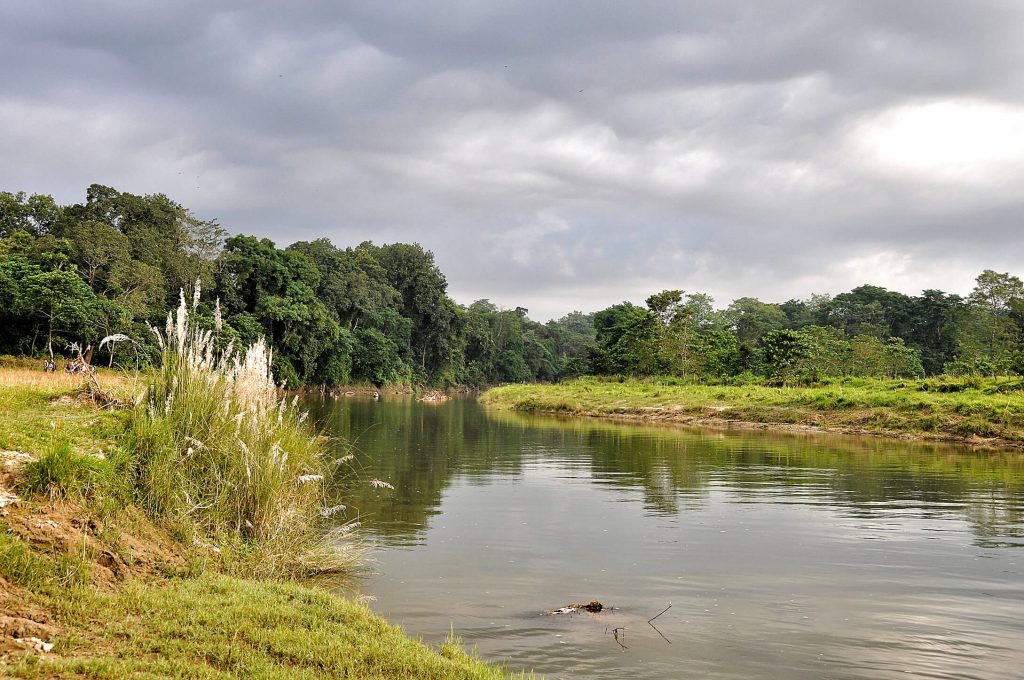
One of the oldest natural heritage sites in Nepal is Chitwan National Park. The national park is a habitat to a host to wild animals;the park shelters the endangered one-horned rhinoceros and Royal Bengal tiger. The park is also home to sloth bears, gharials, and wild elephants. Chitwan National Park is also one of the best spots for bird watching. Birds such as kingfisher, Bengal floricans, grass warblers, storks, egrets, etc., are found in the park.
Highlights of Chitwan National Park
- Explore the habitat of the endangered one-horned rhino and Royal Bengal tiger.
- Take a jeep safari into the wilderness and watch the wild creatures without upsetting their natural environment.
- Stroll around a Tharu village and observe their lifestyle
- Enjoy a canoe ride on the Rapti River
Entry Fee
For SAARC nationals: NPR 1000
For other tourists: NPR 2000
How to get to Chitwan?
Take a tourist or local bus to Chitwan from Kathmandu. It takes about 5-6 hours to reach Chitwan. You can also take a flight to Chitwan. The flight lands at Bharatpur Airport. The flight duration is about 20 min, and upon reaching Bharatpur, you will have to drive for about 40 minutes to reach Chitwan National Park.
Sagarmatha National Park
Location: Sagarmatha National Park, Solukhumbu District, Koshi Province; Established date: 19 July 1976; Listed: World Heritage Site in 1979; Highlight: Home to Mount Everest and rich Sherpa culture.
First Himalayan National Park of Nepal - Sagarmatha National Park
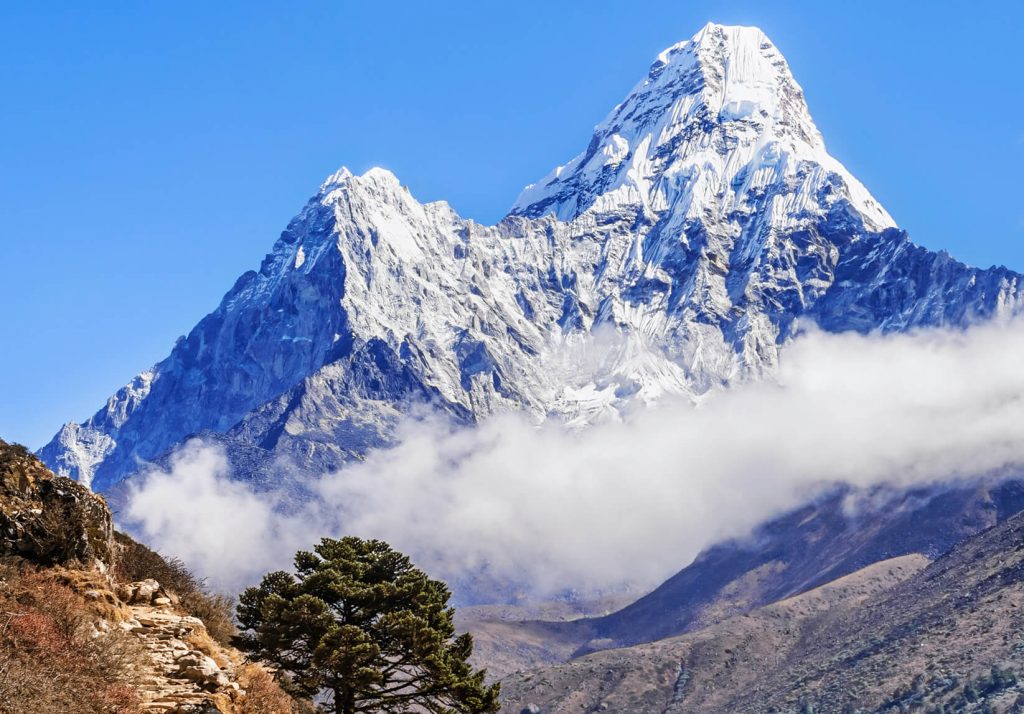
The first Himalayan national park designated a World Heritage Site is Sagarmatha National Park. The park is a rare territory of mountains, glaciers, ice caps, and deep valleys inhabited by Sherpas. The national park has some of the world’s highest mountains, including Mount Everest, the tallest mountain globally. It is a storehouse of rare Himalayan herbs, flowers, and wildlife. Sagarmatha National Park has the most famous trekking destination globally, the Everest Base Camp.
Highlights of Sagarmatha National Park
- Mount Everest, the tallest mountain in the world, lies inside the park
- The park also shelters several 8000, 7000, and 6000-meter peaks
- Gokyo Lakes, the highest freshwater lake system in the world, lies inside the park
- Snow leopards, Himalayan tahr, Blue Sheep, Red Panda, etc., are some of the wild inhabitants
- Traditional Sherpa villages that have preserved ancient Buddhist culture and heritage are located inside the park
Entry Fee
For SAARC nations: NPR 1500
For other tourists: NPR 4000
How to get to Sagarmatha National Park?
The most straightforward approach to arrive at Sagarmatha National Park is to travel to Lukla and trek alongside the rich wildernesses of the national park. One can fly to Lukla from Kathmandu or Ramechhap. Alternatively, you can trek to Lukla from Jiri. It is easy to get public or private transportation from Kathmandu to Jiri.
Check out our popular treks and hikes in Sagarmatha National Park:
Everest Base Camp Trek -16 day
14-day Nepal Everest Base Camp Short Trek
22-day Everest High Passes Trek
14-days Gokyo Lake Renjo La pass trek
FAQs about Nepal Heritage Sites
What are the 7 world heritage sites in Kathmandu? How many World Heritage sites in Kathmandu?
There are 7 UNESCO World Heritage Sites within the Kathmandu Valley. The 7 UNESCO World Heritage Sites within the Kathmandu Valley are: Durbar Squares of Kathmandu (Hanuman Dhoka), Patan (Lalitpur), and Bhaktapur; the Buddhist stupas of Swayambhunath (Monkey Temple) and Boudhanath; and the Hindu temples of Pashupatinath and Changu Narayan.
- Durbar Squares:;Kathmandu, Patan, and Bhaktapur each feature a Durbar Square, which were once the royal centers of their respective cities, showcasing intricate architecture and historical significance.
- Buddhist Stupas:;Swayambhunath (Monkey Temple) and Boudhanath are iconic Buddhist stupas, representing important religious sites in Nepal.
- Hindu Temples: Pashupatinath and Changu Narayan are revered Hindu temples, Pashupatinath being a major pilgrimage site and Changu Narayan being one of the oldest temples in Nepal.
Is Lumbini a World Heritage Site?
Yes, Lumbini, the birthplace of the Buddha, is a UNESCO World Heritage Site. It was inscribed on the World Heritage List in 1997. The site is located in Western Nepal and holds significant religious, cultural, and spiritual importance. It is considered a holy place for Buddhists and attracts pilgrims from around the world.
What is the first heritage of Nepal?
The first World Heritage Site in Nepal, listed by UNESCO, is Sagarmatha National Park, also known as the Everest Region. It was added to the list in 1979. The Kathmandu Valley, also including the Boudhanath Stupa, Pashupatinath Temple, and Kathmandu Durbar Square, was added to the list in the same year.
Is Pashupatinath Temple a world heritage site?
Yes, Pashupatinath Temple in Kathmandu, Nepal is a UNESCO World Heritage Site. It was inscribed on the list in 1979 as part of the broader Kathmandu Valley World Heritage site. The temple complex is a significant religious and cultural landmark, and a major pilgrimage destination for devotees of Lord Shiva.
Three heritage site: What are three heritage sites?
Three UNESCO World Heritage Sites are Lumbini (birthplace of Buddha), Kathmandu Valley (containing several Durbar Squares and temples), and Sagarmatha National Park (home to Mount Everest), all located in Nepal. Lumbini is a significant Buddhist pilgrimage site, Kathmandu Valley showcases Newari architecture and religious coexistence, and Sagarmatha National Park is a natural wonder with high mountains and diverse wildlife.
What is the meaning of heritage site?
A heritage site is a place of cultural or natural significance that is recognized for its Outstanding Universal Value and is considered to be of common importance for all humanity. These sites are often inscribed on the World Heritage List by UNESCO, which is a designation indicating they should be protected for future generations.
- Outstanding Universal Value (OUV): This refers to the exceptional cultural or natural significance of a site, often transcending national boundaries and holding importance for all of humanity.
- Cultural and Natural Heritage:;Heritage sites can be either cultural, such as ancient ruins or historic buildings, or natural, like national parks or coral reefs.
- World Heritage List:;The World Heritage List is a list compiled by UNESCO, which identifies and recognizes sites of outstanding universal value. ;
- Protection and Preservation:;Designation as a World Heritage Site often means that the site receives increased attention and protection, with international collaboration to ensure its preservation.
What is the purpose of a heritage site?
The primary purpose of a heritage site, whether cultural or natural, is to preserve and protect places of Outstanding Universal Value that are of significant importance to humanity and transcend national boundaries. These sites serve as invaluable resources for education, research, and cultural understanding. Additionally, heritage sites can contribute to economic development through tourism and the revitalization of communities.
How many heritage sites are there in Nepal?
Nepal has four UNESCO World Heritage Sites, comprising ten locations in total. Of these, eight are cultural sites; including the seven monument zones of the Kathmandu Valley and Lumbini, the birthplace of Buddha. The remaining two are natural: Sagarmatha National Park, home to Mount Everest, and Chitwan National Park, known for its diverse wildlife. These sites reflect Nepal’s deep spiritual roots, rich history, and stunning ecological diversity.
Conclusion: Discover the Top 10 UNESCO Heritage Sites in Nepal
These 10 World Heritage Sites are Nepal’s cultural and natural treasures. These are legacies that the Nepalese should protect and preserve as they are directly linked to their identity. These heritage sites make Nepal a great country and a destination worth visiting internationally. The World Heritage Sites are the country’s pride, and their preservation should be given the utmost priority by the Nepalese.



Post a Comment